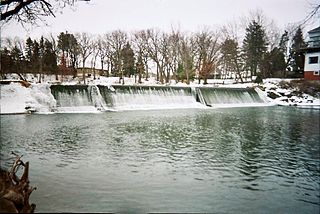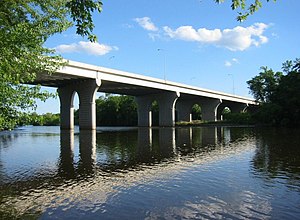
The Mississippi River is the primary river of the largest drainage basin in the United States. From its traditional source of Lake Itasca in northern Minnesota, it flows generally south for 2,340 miles (3,766 km) to the Mississippi River Delta in the Gulf of Mexico. With its many tributaries, the Mississippi's watershed drains all or parts of 32 U.S. states and two Canadian provinces between the Rocky and Appalachian mountains. The river either borders or passes through the states of Minnesota, Wisconsin, Iowa, Illinois, Missouri, Kentucky, Tennessee, Arkansas, Mississippi, and Louisiana. The main stem is entirely within the United States; the total drainage basin is 1,151,000 sq mi (2,980,000 km2), of which only about one percent is in Canada. The Mississippi ranks as the world's tenth-largest river by discharge flow, and the largest in North America.

Saint Paul is the capital of the U.S. state of Minnesota and the county seat of Ramsey County. Situated on high bluffs overlooking a bend in the Mississippi River, Saint Paul is a regional business hub and the center of Minnesota's government. The Minnesota State Capitol and the state government offices all sit on a hill close to the city's downtown district. One of the oldest cities in Minnesota, Saint Paul has several historic neighborhoods and landmarks, such as the Summit Avenue Neighborhood, the James J. Hill House, and the Cathedral of Saint Paul. Like the adjacent city of Minneapolis, Saint Paul is known for its cold, snowy winters and humid summers.

The Great River Road is a collection of state and local roads that follow the course of the Mississippi River through ten states of the United States. They are Minnesota, Wisconsin, Iowa, Illinois, Missouri, Kentucky, Tennessee, Arkansas, Mississippi and Louisiana. It formerly extended north into Canada, serving the provinces of Ontario and Manitoba. The road is designated as both a National Scenic Byway and an All-American Road in several states along the route.

Paynesville is a city in Stearns County, Minnesota, United States, on Lake Koronis, in the central part of the state. The population was 2,388 at the 2020 census. It is part of the St. Cloud Metropolitan Statistical Area.

Hastings is a city mostly in Dakota County, Minnesota, of which it is the county seat, with a portion in Washington County, Minnesota, United States. It is near the confluence of the Mississippi, Vermillion, and St. Croix Rivers. The population was 22,154 at the 2020 census. It is named for the first elected governor of Minnesota, Henry Hastings Sibley.

The St. Croix River is a tributary of the Mississippi River, about 169 mi (272 km) long, in the U.S. states of Wisconsin and Minnesota. The lower 125 mi (201 km) of the river form the border between Wisconsin and Minnesota. The river is a National Scenic Riverway under the protection of the National Park Service. A hydroelectric plant at the Saint Croix Falls Dam supplies power to the Minneapolis–Saint Paul metropolitan area.

The Cedar River is a 338-mile-long (544 km) river in Minnesota and Iowa. It is a tributary of the Iowa River, which flows to the Mississippi River. The Cedar River takes its name from the red cedar trees growing there, and was originally called the Red Cedar River by the Meskwaki. The first Mississippi steamboat reached Cedar Rapids, Iowa in 1844, and during the next decade, the Red Cedar was an important commercial waterway. The surrounding region is known officially as the Cedar River Valley, though it is more commonly referred to simply as the Cedar Valley. The stream is young geologically, and only in places where the glacial material has been removed is the underlying bedrock exposed.

Patricia Lynn Wetterling is an American advocate of children's safety and chair of the National Center for Missing and Exploited Children. Her advocacy particularly focuses on protecting children from abduction and abuse. She has become one of the most vocal critics of current sex offender registry laws, painting them as overly broad and unnecessarily causing tremendous harm to many. Her advocacy began after her son Jacob was abducted in 1989 and culminated in passage of the federal Jacob Wetterling Crimes Against Children and Sexually Violent Offender Registration Act. She was a candidate for the Minnesota Sixth District seat in the United States House of Representatives as the Democratic-Farmer-Labor Party candidate in 2004 and 2006, losing to Republicans Mark Kennedy and Michele Bachmann respectively. In September 2016, the remains of her son Jacob were discovered and positively identified.

Jacob Erwin Wetterling was an American boy from St. Joseph, Minnesota, who was kidnapped from his hometown and murdered on October 22, 1989, at the age of 11. The identity of his abductor remained a mystery for nearly 27 years.

Minnehaha Park is a city park in Minneapolis, Minnesota, United States, and home to Minnehaha Falls and the lower reaches of Minnehaha Creek. Officially named Minnehaha Regional Park, it is part of the Minneapolis Park and Recreation Board system and lies within the Mississippi National River and Recreation Area, a unit of the National Park Service. The park was designed by landscape architect Horace W.S. Cleveland in 1883 as part of the Grand Rounds Scenic Byway system, and was part of the popular steamboat Upper Mississippi River "Fashionable Tour" in the 1800s.

The Mendota Bridge, in the US state of Minnesota carries State Highway 55 (MN 55) and MN 62 over the Minnesota River between Fort Snelling and Mendota Heights. It is the final bridge over the Minnesota River before the Minnesota flows into the Mississippi River at the "Meeting of the waters" or "Mendota" in the Dakota language. Traffic on the north end of the bridge may turn onto the Fort Road Bridge (MN 5) to cross the Mississippi River into Saint Paul, Minnesota. The skylines of both Minneapolis and Saint Paul can be seen simultaneously from the bridge.

The Jacob Wetterling Crimes Against Children and Sexually Violent Offender Registration Act, colloquially known as the Wetterling Act, is a United States law that requires states to implement a registry of sex offenders and crimes against children. It is named for Jacob Wetterling, a Minnesota eleven-year-old who was abducted by a stranger in 1989, and was missing for almost 27 years until his death was confirmed when his remains were found on September 1, 2016.

Ford Dam, officially known as Lock and Dam No. 1, is on the Upper Mississippi River and is located between Minneapolis and Saint Paul, Minnesota just north of the confluence of the Mississippi with the Minnesota River at Mississippi River mile 847.9, in Minneapolis. The powerhouse portion was previously owned by the Ford Motor Company, which operated a hydroelectric power station to feed electricity to its Twin Cities Assembly Plant on the east side of the river. It was sold to Brookfield Power Co. in April 2008. The dual-lock facility and dam was built and is operated by the St. Paul district of the U.S. Army Corps of Engineers' Mississippi Valley Division.

Northern Pacific Bridge #9 is a deck truss bridge that spans the Mississippi River in Minneapolis, Minnesota, between the Seven Corners area and the University of Minnesota campus. It was built in 1924 and was designed by Frederick W. Cappelen. Railroad use of the bridge ended in 1981, and in 1999 the bridge was opened to bicycles and pedestrians. It replaced the former Northern Pacific "A Line" bridge.
The 2006 Minnesota's 6th congressional district election was an election for the United States House of Representatives. State senator Michele Bachmann of the Republican Party defeated child safety advocate Patty Wetterling of the Democratic-Farmer-Labor Party, and project co-ordinator John Binkowski of the Independence Party.

Bohemian Flats Park is a park in Minneapolis, Minnesota, United States on the west bank of the Mississippi River near the Washington Avenue Bridge and next to the University of Minnesota campus. The area, once known as Little Bohemia, was the site of a shanty town as Minneapolis was incorporated in 1867. European immigrants seeking employment in the city or at the mills at the nearby St. Anthony Falls settled there. The former housing structures and historic buildings no longer remain. The park is managed by the Minneapolis Park and Recreation Board as part of the Mississippi Gorge Regional Park, and it lies within the Mississippi National River Recreation Area.

Shepard Road and Warner Road are the names given to a four-lane road running along the banks of the Mississippi River in Saint Paul, Minnesota. Shepard Road runs from the southwestern boundary of the county to downtown Saint Paul. From downtown east the road is known as Warner Road. It runs to a junction with US Highways 61 and 10.

Raspberry Island is located in the Mississippi River in Saint Paul, Minnesota, United States. Buildings for the Minnesota Boat Club have sat upon the island since 1885; the Minnesota Boat Club Boathouse structure was built in 1910. Between 1949 and 1968, the island was used by the United States Navy. The City of Saint Paul manages the island as part of the Harriet Island Regional Park. Paths, a plaza, and a bandshell were installed on Raspberry Island during renovations by the city in the early 2000s.

The 2006 congressional elections in Minnesota were held on November 7, 2006, to determine who would represent the state of Minnesota in the United States House of Representatives.

In the Dark is an investigative journalism podcast hosted by Madeleine Baran, and produced by Samara Freemark, The New Yorker, and Condé Nast Entertainment. The series launched in September 2016 at American Public Media (APM), featuring in-depth reportage from APM's investigative reporting and documentary unit, APM Reports. Two full seasons were produced, each focusing on a high-profile case and the actions and conduct in the policing or prosecuting of those cases—the kidnapping/murder of Jacob Wetterling and the quadruple homicide case for which Curtis Flowers was tried 6 times. A subsequent "Special Report" series, released in spring 2020, reported on the impact of the COVID-19 pandemic in the Mississippi Delta. The series was cancelled in May 2022 as part of APM's dissolving of APM Reports and "incorporating select programming elements" from the unit into its MPR News operation.




















